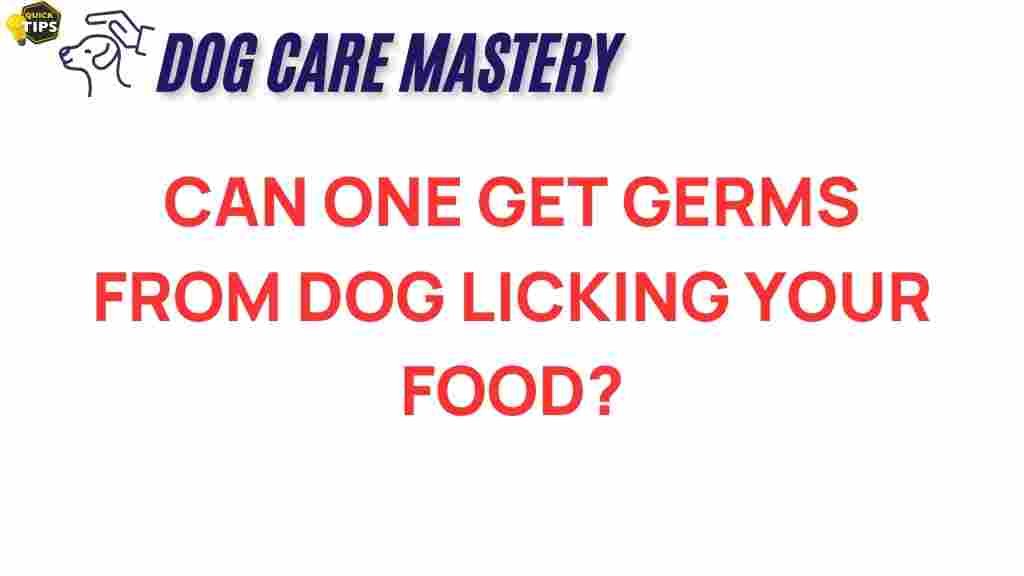Can a Dog’s Kiss Contaminate Your Meal? Understanding the Risks of Dog Licking Food
When it comes to our beloved pets, many dog owners find it hard to resist the urge to let their furry friends show affection, even if it involves a slobbery kiss. However, the question arises: can a dog’s kiss contaminate your meal? This article dives deep into the potential risks associated with dog licking food and provides valuable insights into keeping your meals safe and enjoyable.
The Reality of Dog Licking Food
Dogs are known for their unfiltered enthusiasm, and their method of showing love often includes licking. While this behavior can be endearing, it does raise concerns about hygiene, especially when it comes to food. Here are some essential points to consider:
- Dog saliva contains bacteria: Just like humans, dogs have bacteria in their mouths. Some of these bacteria are harmless, while others can pose health risks to humans.
- Food contamination risk: When a dog licks food, there’s a possibility of transferring these bacteria, which can lead to foodborne illnesses.
- Allergens and parasites: Dogs can carry allergens and parasites in their mouths, which can also contaminate food.
Understanding Dog Saliva
Dog saliva is not just a simple liquid; it has a complex composition that includes enzymes, bacteria, and other microorganisms. Some key elements include:
- Enzymes: These help in digestion but can also break down food components, making them more susceptible to bacterial growth.
- Bacteria: A dog’s mouth is home to various bacteria, some of which are pathogenic and can lead to infections in humans.
- Viruses and pathogens: Dogs can carry viruses and pathogens that are transmissible to humans through saliva.
The Risks of Dog Licking Food
Now that we understand what’s in dog saliva, let’s take a closer look at the potential risks associated with dog licking food:
- Gastrointestinal issues: Ingesting bacteria from dog saliva can lead to gastrointestinal problems, including nausea, vomiting, and diarrhea.
- Infections: Certain bacteria can cause infections that may require medical attention, especially in individuals with weakened immune systems.
- Allergic reactions: If a dog has been exposed to certain allergens, these can be transferred to food through licking.
How to Minimize Risks Associated with Dog Licking Food
If you share your home with a dog, it’s essential to take proactive measures to minimize the risks of contamination. Here’s a step-by-step process to ensure a safe dining experience:
1. Create Separate Eating Spaces
Designate a separate area for your dog to eat and ensure it’s away from where you prepare and consume your meals. This will help reduce the likelihood of your dog interacting with your food.
2. Train Your Dog
Training your dog not to lick your food or your hands can significantly reduce contamination risks. Use positive reinforcement techniques to encourage good behavior:
- Teach commands such as “leave it” or “no lick” to discourage licking.
- Reward your dog with treats or praise when they follow these commands.
3. Wash Hands and Surfaces
Always wash your hands before preparing food and ensure that all surfaces are clean. This practice not only protects against bacteria from dog saliva but also ensures a hygienic cooking environment.
4. Avoid Sharing Food
While it may be tempting to share your meal with your dog, it’s best to avoid this practice. Instead, offer them dog-safe treats to satisfy their cravings without compromising your meal’s safety.
5. Regular Vet Check-ups
Ensure that your dog is healthy and free from parasites or infections by scheduling regular veterinary check-ups. This will help minimize the risk of carrying harmful pathogens in their saliva.
6. Educate Family and Friends
If you have guests over, inform them about your pet’s licking habits. Encourage them to avoid letting the dog lick their food or hands, as this can help maintain a safe environment.
Troubleshooting Tips for Dog Owners
Even with the best intentions, accidents can happen. Here are some troubleshooting tips if you find yourself in a situation where your dog has licked your food:
1. Assess the Situation
If your dog has licked your food, first assess the extent of the contamination. Consider the following:
- Was the food raw or cooked?
- How much of the food was licked?
- Is your dog healthy, and has it been vaccinated?
2. Make a Decision
Based on your assessment, you may choose to:
- Discard the food if you feel it’s unsafe.
- Remove the licked portion if it’s a small amount and the rest is safe.
3. Monitor for Symptoms
If you decide to consume the food, monitor yourself for any symptoms of foodborne illness. If you experience any unusual symptoms, consult a healthcare professional immediately.
4. Clean Thoroughly
After an incident, make sure to clean the area thoroughly. Use disinfectants on the surfaces where the food was placed to eliminate any bacteria.
Final Thoughts on Dog Licking Food
Ultimately, while a dog’s kiss can be sweet, it’s important to recognize the potential risks associated with dog licking food. By taking preventive measures and practicing good hygiene, you can enjoy the companionship of your beloved dog while keeping your meals safe. So the next time your furry friend tries to sneak a lick, remember the importance of maintaining a clean and safe eating environment.
For more tips on keeping your home clean and safe for both you and your pets, check out our guide on preventing pet-related health issues. And be sure to stay updated on the latest pet care practices by visiting reliable veterinary resources.
This article is in the category Safety and created by dogcaremastery Team
